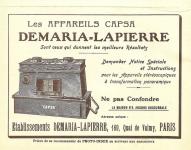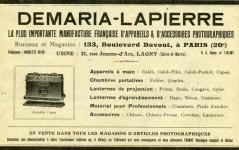|
Demaria-Lapierre Capsa |
Manufactured or assembled in France from (Circa) 1900 to (After) 1900.
Index of rarity in France: Rare (among non-specialized garage sales)
Inventory number: 1368
See the complete technical specifications
Chronology of cameras Demaria-Lapierre
This type of camera is called a "jumelle" ( jumelle means binoculars in French) . Do not issue too quick conclusions ! This name has nothing to do with the fact that there are two lenses, but with the fact that , unlike the camera of the same time, you hold the camera in front of your eyes , as you would with binoculars.
The "jumelles" are devices whose shape is characterized by a front plate supporting the lens and a rigid chamber in the shape of a truncated pyramid , taking the form of a bellows. They may be equipped with a interchangeable multi- plates holder. When fitted with a pair of lenses , we call them Jumelle stereo . I have already presented a jumelle , manufactured by Bellieni Nancy and a stereo model , the Glyphoscope Richard .
All controls are in front , between the two Kelar lenses. A rotating knob is used to select between an instant (which makes a klong noise ) and time exposure ( two times ) . A cursor is just below this button and allows you to cock the two shutters. The second cursor , a little lower , allows you to choose one of the three apertures. This cursor is directly welded or screwed to a perforated metal plate with six holes ( two sets of three ) that passes behind the lenses.
The rotating knob which directs to the values 1-5 yet keeps its mystery.
The unit is all metal . It is heavy, but very rigid, which allows to have a large tripod socket . There is no adjustment of distance . A viewfinder located above the unit allows framing ... approximate .
The plate holder seems to contain about 12 plates, if we believe the counter located above .
On the back side , a slider is used to prevent the penetration of light into the magazine. The cursor must be positioned on "open" as soon as you want to take a photo, and of course stay closed when the holder is not mounted on the housing of the camera.
Once the photograph has been taken , you must pull on the large side handle . By a retraction game the exposed plate leaves room for a new unexposed plate . Unloading / loading the magazine must be done in a darkroom.
At the same time , the "Detective " cameras also offered the ability to load multiple plates, but their use is more difficult ( problem of sight) and the plates have the annoying tendency to break during retraction . A jumelle is more practical than a detective camera.

The history of photography sometimes resembles a family tree.
The history of the Demaria-Lapierre-Mollier brand is a bit complicated. The obituary notice of Jules Demaria sheds some light on it. Two brothers, Jules (1866-1950) and Paul, joined forces in 1897 to manufacture cameras. This partnership between the brothers does not date back to 1848, as I have read here and there, since Jules was born only in 1866. The company they inherited from their family dates back to that year, and they later named it Demaria Frères (DMR).
In 1908, they absorbed the Lapierre company (DL).
In 1911, Jules separated from the partnership and founded the Jules Demaria company, registering the Jidé brand (phonetic for his initials).
In 1929/30, Demaria-Lapierre acquired the company of d'Etienne Mollier, and the company became Demaria-Lapierre-Mollier.

An article, perhaps better described as a sponsored feature, in the March 1931 issue of "L'Instantané" magazine recalls what the company was like at that time and delves into its history.

The Société Anonyme des Etablissements DEMARIA-LAPIERRE et MOLLIER was established in 1930 through the merger of the DEMARIA Frères, founded in 1848, LAPIERRE Frères et Cie, established in 1840, and MOLLIER et Cie, founded in 1923. Originally located at 169 Quai Valmy and 67 Rue des Archives, the company's headquarters are currently situated at 133 Boulevard Davout in Paris (20th arrondissement).
The company owns a factory in Lagny-sur-Marne, covering an area of approximately 7,000 square meters and employing over 120 workers.
The product range of Etablissements DEMARIA-LAPIERRE et MOLLIER includes various models of equipment and accessories for photography, projection, enlargement, and cinema:
1. Handheld cameras for plates and films of all formats.
2. Portable darkrooms for professional photographers.
3. Projectors for transparent and opaque views.
4. Enlargers with direct and reflected light.
5. Darkrooms and workshop equipment.
6. Laboratory accessories: trays, frame presses, calibrators, lanterns, retouching desks, printers, etc.
7. Educational cinema equipment.
8. Illuminated advertising devices.
In addition to the above-mentioned items, the modern organization of its workshops enables the DEMARIA-LAPIERRE et MOLLIER company to undertake significant custom work, including:
1. Aviation photographic equipment and materials.
2. Film rolls, sheet metal parts, and accessories for cinematography.
3. Magic lanterns and toy projectors.
4. Wooden boxes and cases for scientific and military equipment.
5. Optical and industrial photography equipment.
The history of the Société des Etablissements DEMARIA-LAPIERRE ET MOLLIER is marked by the merger of various companies:
- DEMARIA Frères, founded in Paris in 1858
- LAPIERRE Frères, founded in 1848
- MOLLIER et Cie, established in 1902
- Acquisition of other companies over time, including AUBERT, BOULANGER, MAUGENET, LEUZINGER et PINSON, BRUNET, LABORDE
The company initially focused on photographic manufacturing and closely followed the advancements in the field, from producing negatives, glassware, mirrors, accessories, and cameras to projection and enlargement equipment, up to contemporary technology.
From 1858 to 1908, the DEMARIA factories expanded significantly and were equipped with modern tools, located at Quai Jemmapes and Quai Valmy in Paris. Their manufacturing extended to:
- Handheld detective cameras
- Folding handheld cameras
- Tourist darkrooms in various formats
- Equipment for professionals
- Projectors and enlargers of all kinds
- Cinematography, filming, and projection
- Anastigmatic lenses and various other accessories for laboratories
- Special equipment for industrial photography
The DEMARIA house gained international recognition, supplying major ministries, government agencies, scientific institutions, observatories, educational institutions, and more. It received accolades at international exhibitions, including Paris 1900, Hanoi 1902, and Milan 1906, and won first prizes at Saint-Louis 1904, Liège 1905, Bucarest 1906, and London Saragossa 1908.
In 1908, it merged with the LAPIERRE company, which had established a lens condenser factory in Lagny-sur-Marne in 1900, primarily serving the English market. In 1913, it developed the first telephotography camera and dedicated its efforts to wartime production from 1914 to 1918, creating numerous models of aviation cameras, special photographic and projection equipment, and mobile laboratory equipment for the military.
In 1920, the Société D'OPTIQUE et de MECANIQUE de HAUTE PRECISION acquired DEMARIA-LAPIERRE, located at 125 Boulevard Davout in Paris, leading to further expansion and modernization of its factory and the development of new models. In 1930, it merged with the MOLLIER establishments, known for their metallic photographic equipment, precision general mechanics, and the manufacture of cinematographic equipment and projection materials.
Today, DEMARIA-LAPIERRE's product range encompasses a complete range of photography and projection equipment, accessories, some cinematographic models, and various specialized materials. Regaining its autonomy from the Société D'OPTIQUE et de MECANIQUE de HAUTE PRECISION, supported by extensive experience, conscientious technicians, cutting-edge tools, and a sprawling one-hectare factory, DEMARIA-LAPIERRE is poised for future growth as a significant industry player.
Obituary of one of the two Demaria brothers in May 1950.

Interesting links or bibliography :
 Photo-Index de 1913 |  La Revue Française de Photographie de 07/1925 |
Add a link or element of bibliography, a picture taken with this camera, a picture of box or an ads about this camera
Your photos taken with the same camera:
Cameras from Ebay France (Demaria-Lapierre) (Uploaded each 3 hours)
 appareil photo folding DEMARIA LAPIERRE DEHEL 6x9 made in France 1948 15,00 euros Finira le 20-05-2024 à 14:12:20 |  appareil photo à soufflet dehel demaria lapierre manar 9,90 euros Finira le 23-05-2024 à 11:00:59 |  Rare ancien appareil photo DEMARIA LAPIERRE TELKA XX avec son étui 80,00 euros Finira le 25-05-2024 à 22:25:13 |








